Satas D., Tracton A.A. (ed.). Coatings Technology Handbook
Подождите немного. Документ загружается.


322
BHAT
such as abrasion resistance, oxidation resistance, thermal shock resistance, and compatible
thermal expansion characteristics, are also important. Thus, typical coatings used in these
applications include certain refractory metals, A1203. B&, Sic, Si3N4, Si02, and
ZrOz,
and refractory metal silicides. Composite coatings such as A1203
+
Zr02
and A1203
+
Y203
have also been studied. Most of these coatings can be deposited by CVD. Typical applica-
tions for these coatings include rocket nozzles, reentry cones, ceramic heat exchanger
components, afterburner parts in rocket engines, and gas turbine and automotive engine
components. Another well-known example of a protective refractory coating is the SiC-
coated hardware used in the microelectronics field for manufacturing coated silicon wafers.
Figure
8
shows typical examples
of
graphite susceptor components coated with Sic. An
iridium-coated rhenium thrust chamber for spacecraft was shown in Figure
2.
In recent years, advances in the technology of carbon-carbon composites have led
to the fabrication of components out of these materials, which are then coated by CVD
or
the new technology of chemical vapor infiltration (CVI) with various refractory compound
coatings, most notably Sic. Other ceramic fiber composites based on alumina and silica
have also been coated in a similar manner for high temperature service. Figure
9
illustrates
one of the techniques used for coating
of
porous
fiber
preforms by CVI.
The more exotic CVD techniques that were mentioned earlier, such as PACVD and
LCVD,
have found important applications for the deposition of new types of coatings.
.-
'
Figure
8
Photograph
of
graphite susceptor components coated with
CVD
Sic.
These components
are used in the microelectronic industry as supports
for
wafers during depositlon
of
vanous
thin
films.

CHEMICAL
VAPOR
DEPOSITION
323
HOT
ZONE
EXHAUST
GAS
COATING
GAS
Figure
9
Schematic diagram showing a technique of chemical vapor infiltration of porous fiber
preforms, in which a coating
of
a protective material such as Sic
1s
deposited. In this method, a
thermal gradient across the preform allows
diffusion
of the reactive gas mixture progressively from
the hot surface to the cold surface, uniformly coating the preform. (Data from Stinton, et
al.,
Ceramic
Bulletin,
vol.
65,
p. 347
(1986).
Reprinted with permission from the American Ceramic Society,
Westerville,
OH.)
A
(11
1.0
RAMAN
SPECTRUM OF DIAMOND
FILM
1
:F
500
m
lo00
1250
1500 1750
WAVENUMBERS
C
LSER50MW515t*2NNM.SCITS:lOOUlCMtE~
1
SC*N
(S).
TIME:
1
SEW,
mS
SPICED
BI
1
W*yMuyBQIB
Figure
10
Photographs showing diamond crystals (A) and polycrystalline diamond film (B)
deposited on a silicon wafer substrate by microwave plasma-enhanced
Cm,
from a gas mixture
containing hydrogen and methane. The Raman spectrum
(C)
clearly shows the characteristic Raman
shift
for
diamond at
1332
cm". (Data courtesy
of
Dm.
R. Messier, Materials Research Laboratory,
The Pennsylvania State Unwersity, and P.
K.
Bachmann, Philips Research Laboratories, Eindhoven,
The Netherlands.)

324
BHAT
One
of
the most interesting applications is the deposition of diamond films by PACVD.
The diamond films have unique properties and application potential ranging from wear-
resistant coatings for cutting tools
to
coatings for laser mirrors. fiber-optics. dielectric
films, and heat sinks in microelectronic circuits. Figure
10
shows an example
of
a
diamond
film deposited on silicon, with the characteristic Raman peak at
1332
cm”. Coatings
deposited by the LCVD technique find applications
in
laser photolithography. repair
of
VLSIC masks, laser metallization, and laser evaporation-deposition.
4.0
SUMMARY
The chief characteristics of CVD may be summarized as follows:
l.
2.
3.
4.
5.
6.
7.
8.
9.
IO.
The solid is deposited by means of a vapor phase chemical reaction between
precursor compounds
in
gaseous form at moderate
to
high temperatures.
The process can be carried out at atmospheric pressure as well as at low pres-
sures.
Use
of
plasma and laser activation allows significant energization
of
chemical
reactions, permitting deposition at very low temperatures.
Chemical composition
of
the coating can be varied to obtain graded deposits
or mixtures
of
coatings.
Controlled variations in density and purity
of
the coating can be achieved.
Coatings
on
substrates of complex shapes and on particulate materials can be
deposited in a fluidized-bed system.
Gas tlow conditions are usually laminar, resulting in thick boundary layers at
the substrate surface.
The deposits usually have a columnar grain structure. which is weak
in
flexure.
Fine-grained, equiaxed deposits can be obtained by
gas
phase perturbation of
chemical reactions by various techniques.
Control of vapor phase reactions is critical for achieving desirable properties
in
the deposit.
A wide variety of metals, alloys. ceramics. and compounds can be manufac-
tured as coatings or as free-standing components.
It is clear that chemical vapor deposition is a versatile technique for the deposition
of coatings of a wide variety of materials, as well as for the fabrication of free-standing
structural components.
BIBLIOGRAPHY
T.
M.
Besmann, D.
P.
Stinton, and R.
A.
Lowden. “Chemical Vapor Deposition Techniques,”
MRS
Bulletin.
November 1988.
D.
G.
Bhot, “Chemical Vapor Depositor.” Chapter
2
in
Srrrfitc.~
Modjficntiorr
T~~c~/rrrolo,gir,s-Afr
E~~gI~rwr’.s
Guide
(T.
S.
Sudarshan,
Ed.).
Marccl Dekker. Inc.. New York. NY
(
1989).
p.
141.
J.
M.
Blocher. Jr.. “Chemical Vapor Deposition.” Chapter
X
in
13rpo.sitiorr
Tt~clrr~olo~ir.sJi,r.
Filrrrs
trrltl
Cotrtir~,gs:
L)r,~,~,l~’l”r~~~~t,s
rrrd
Applicrtriot~.s
(R.
F.
Bunshah, et
al.,
cds.), Noyes Publica-
tions, Park Ridge, NJ
(1982).
p.
335.
W.
A.
Bryant. “Chemical
Vapor
Deposition.” Chapter
6
in
Srtr:/itcx)
Mocljficdorr
Errgiw~ritr,q,
Vol.
I:
Arrrrltrrmvrrtrl
Aspt,ct.s
(R. Kossowsky. Ed.). CRC Press. Boca Roton.
FL
(1989).
p.
189.
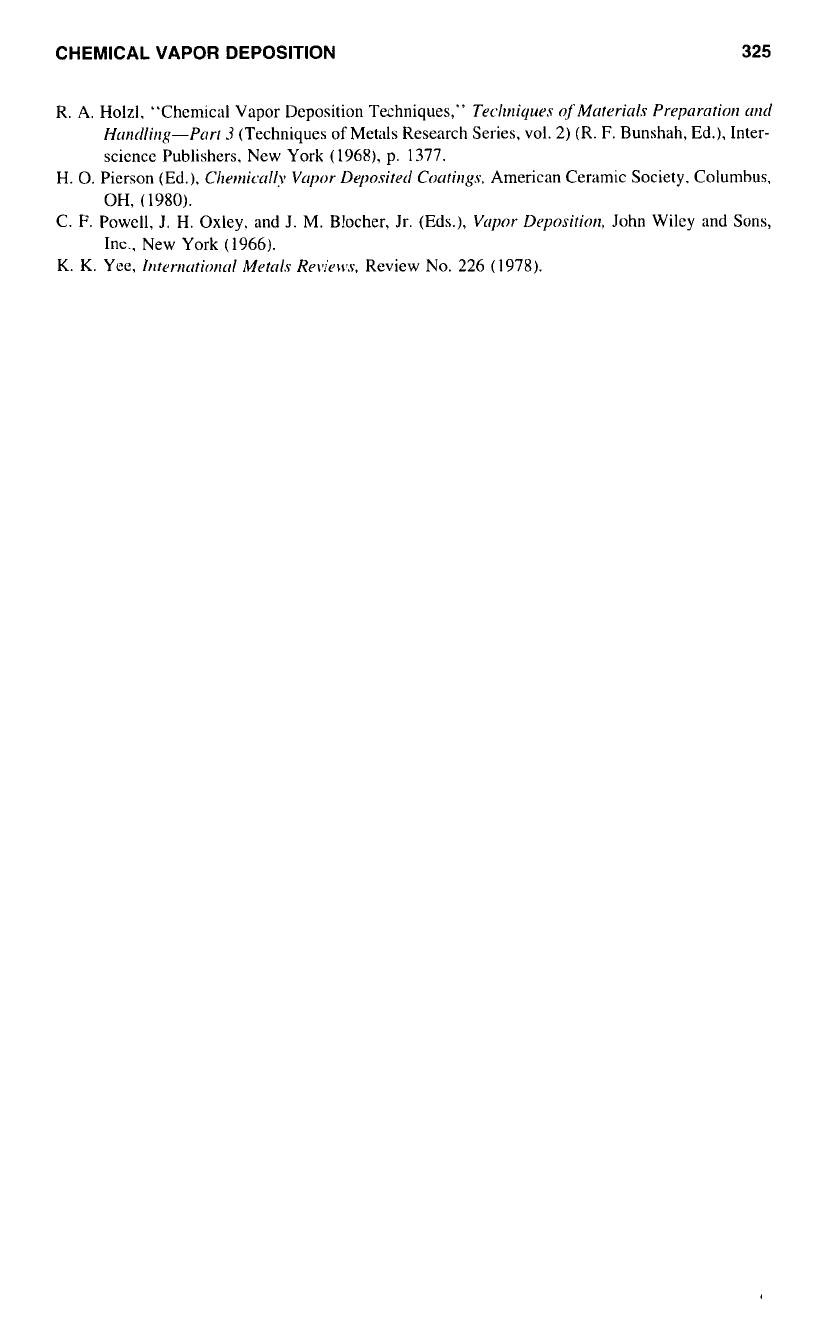
CHEMICAL VAPOR DEPOSITION
325
R.
A.
Holzl.
“Chcmical Vapor Deposition Techniques,”
Techr~iques
oJ’Mccterin/.s
Preparation
terlrl
Httr~//ir~g-Part
3
(Techniques
of
Metals
Research Series, vol.
2)
(R.
F.
Bunshah, Ed.), Inter-
science Publishers. New York
(1968),
p. 1377.
H.
0.
Picrson (Ed.),
Cher~icrc//y
Vrrl,or
Depositet/
Cocctirlgs.
American Ceramic Society. Columbus,
OH,
(
1980).
C.
F.
Powell,
J.
H.
Oxley. and
J.
M.
Blocher, Jr. (Eds.),
Vrcpor
Deposition,
John Wilcy and Sons,
Inc., New York (1966).
K. K.
Yce,
hterntetiorlrrl
Metnls
Re~~iew
Review No.
226
(
1978).
This Page Intentionally Left Blank

Solvent
Vapor
Emission Control
Richard
Rathmell
Londondery,
New
Hampshire
For business operations that include the wet coating
of
a surface, followed by drying, the
amount
of
volatile organic compound (VOC) released to the atmosphere is important.
Increased awareness of ambient air quality, and various regulations affecting solvent vapor
emissions, do not change the need to make a business economically profitable.
1.0
REGULATORY BACKGROUND
For a perspective on the VOC regulations, the government now monitors ambient air
quality to measure several contaminants: particulates (dust), sulfur dioxide
(SO?),
ozone,
and others. The amount of ozone is associated with “smog” and volatile organics in the
air; it is most noticeable
on
hot summer days and in metropolitan areas. Industrial coating
operations are important point sources that may emit tons of VOC. Automotive traffic
and refueling release much more VOC, but the thousands of smaller sources are not as
easy to control.
The federal Clean Air Act of 1961 promulgated an important set of regulations that
establish limits and also require the states to act to meet ambient air quality standards.
State regulations may be more stringent than federal regulations, but not less. Also, local
regulations, such as county, municipal, or regional authority, may be more stringent.
In
some areas, the state or local authorities are judges by some to be too lenient toward
emissions and by others to be antibusiness in enforcement of regulations. In many areas,
the industrial emissions have been reasonably well controlled, but the ambient ozone
standard
of
0.12
ppm ozone has not been attained. (This is unrelated to the “ozone deple-
tion” problem at high altitudes.)
The federal government now discriminates between “attainment areas” and “nonat-
tainment areas.” Regulations also discriminate between New Sources and Existing
Sources. New source performance standards may be based on a cost-benefit analysis, but
in some nonattainment areas a more stringent LAER (lowest achievable emission rate)
327
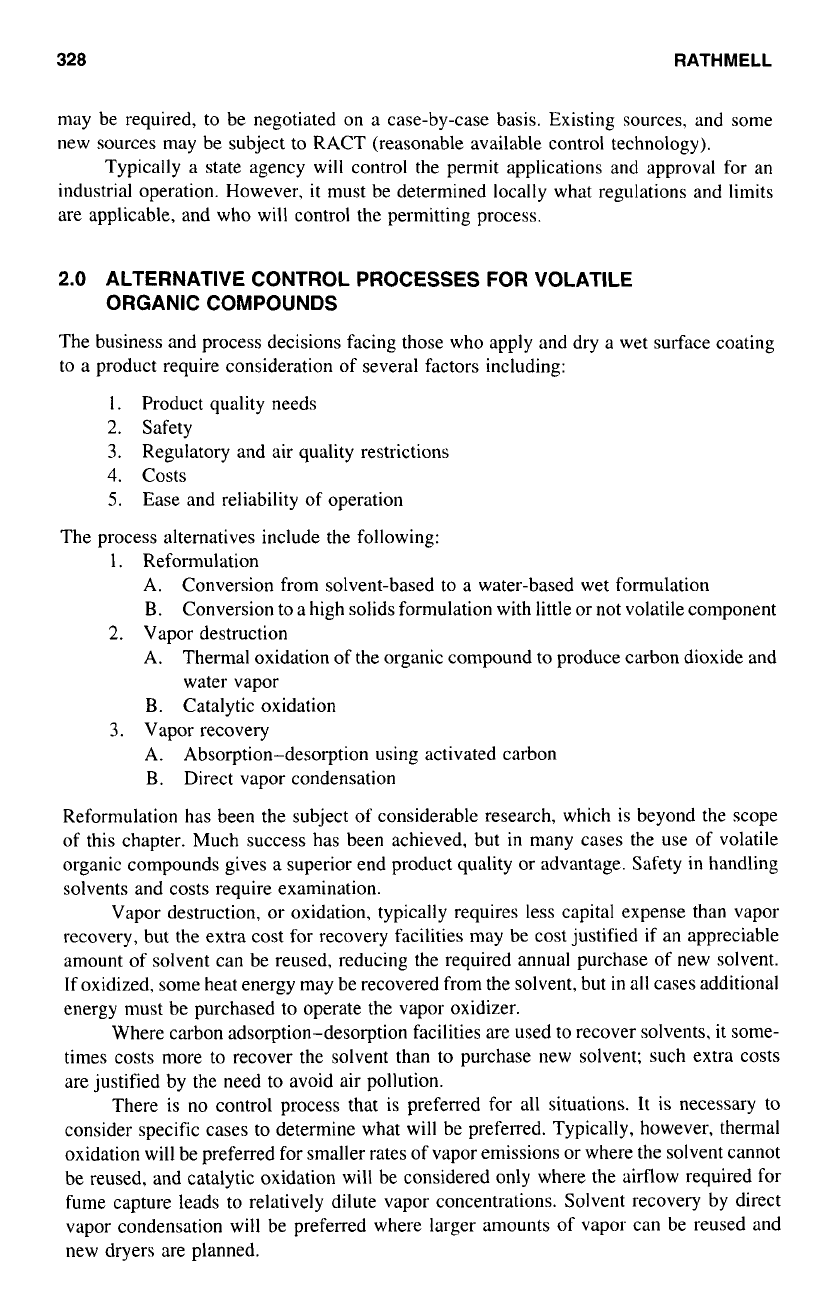
328
RATHMELL
may be required, to be negotiated on a case-by-case basis. Existing sources, and some
new sources may be subject to RACT (reasonable available control technology).
Typically a state agency will control the permit applications and approval for an
industrial operation. However.
it
must be determined locally what regulations and limits
are applicable, and who will control the permitting process.
2.0
ALTERNATIVE CONTROL PROCESSES
FOR
VOLATILE
ORGANIC COMPOUNDS
The business and process decisions facing those who apply and dry a wet surface coating
to a product require consideration of several factors including:
1.
Product quality needs
2.
Safety
3.
Regulatory and air quality restrictions
4.
costs
5.
Ease and reliability
of
operation
The process alternatives include the following:
1.
Reformulation
A. Conversion from solvent-based to a water-based wet formulation
B.
Conversion to a high solids formulation with little or not volatile component
A. Thermal oxidation of the organic compound to produce carbon dioxide and
B.
Catalytic oxidation
A. Absorption-desorption using activated carbon
B.
Direct vapor condensation
2.
Vapor destruction
water vapor
3.
Vapor recovery
Reformulation has been the subject
of
considerable research, which is beyond the scope
of this chapter. Much success has been achieved, but in many cases the use of volatile
organic compounds gives a superior end product quality or advantage. Safety in handling
solvents and costs require examination.
Vapor destruction, or oxidation, typically requires less capital expense than vapor
recovery, but the extra cost for recovery facilities may be cost justified if an appreciable
amount of solvent can be reused, reducing the required annual purchase of new solvent.
If oxidized, some heat energy may be recovered from the solvent, but in all cases additional
energy must be purchased to operate the vapor oxidizer.
Where carbon adsorption-desorption facilities are used to recover solvents, it some-
times costs more to recover the solvent than to purchase new solvent; such extra costs
are justified by the need
to
avoid air pollution.
There is no control process that is preferred for all situations. It
is
necessary to
consider specific cases to determine what will be preferred. Typically, however, thermal
oxidation will be preferred for smaller rates of vapor emissions or where the solvent cannot
be reused, and catalytic oxidation will be considered only where the aifflow required for
fume capture leads to relatively dilute vapor concentrations. Solvent recovery by direct
vapor condensation will be preferred where larger amounts of vapor can be reused and
new dryers are planned.
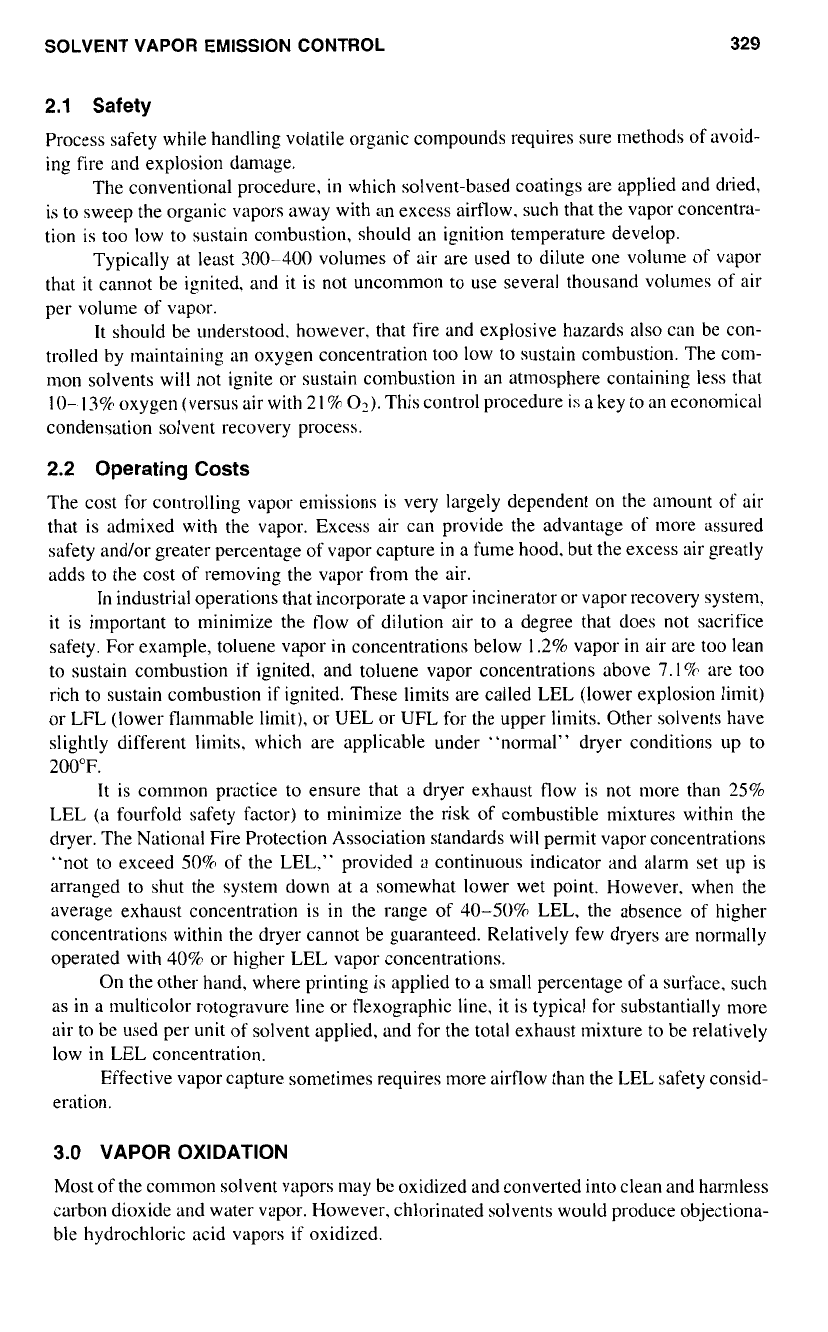
SOLVENT
VAPOR
EMISSION
CONTROL
329
2.1
Safety
Process safety while handling volatile organic compounds requires sure methods of avoid-
ing fire and explosion damage.
The conventional procedure. in which solvent-based coatings are applied and dried,
is
to
sweep the organic vapors away with an excess airflow. such that the vapor concentra-
tion is
too
low
to
sustain combustion, should an ignition temperature develop.
Typically at least
300-400
volumes of air are used
to
dilute one volume of vapor
that
it
cannot be ignited. and
it
is
not
uncommon to use several thousand volumes of air
per volume of vapor.
It
should be understood. however, that fire and explosive hazards also can be con-
trolled by maintaining an oxygen concentration
too
low
to
sustain combustion. The com-
mon
solvents will not ignite or sustain combustion
in
an atmosphere containing less that
10-
13%
oxygen (versus air with
2
1
%
O?).
This control procedure is a key to an economical
condensation solvent recovery process.
2.2
Operating Costs
The cost for controlling vapor emissions is very largely dependent on the amount of air
that is admixed with the vapor. Excess air can provide the advantage of more assured
safety and/or greater percentage of vapor capture
in
a
fume hood. but the excess air greatly
adds to the cost of removing the vapor from the air.
In
industrial operations that incorporate a vapor incinerator or vapor recovery system,
it is important
to
minimize the flow
of
dilution air
to
a degree that does not sacrifice
safety. For example, toluene vapor in concentrations below
1.2%
vapor
in
air are
too
lean
to sustain combustion
if
ignited, and toluene vapor concentrations above
7.1%
are too
rich
to
sustain combustion
if
ignited. These limits are called LEL (lower explosion limit)
or LFL (lower flammable limit), or UEL or UFL for the upper limits. Other solvents have
slightly different limits, which are applicable under "normal" dryer conditions up
to
200°F.
It
is common practice to ensure that a dryer exhaust flow is not more than
25%
LEL
(a
fourfold safety factor) to minimize the risk
of
combustible mixtures within the
dryer. The National Fire Protection Association standards will permit vapor concentrations
"not to exceed
50%
of the LEL." provided a continuous indicator and alarm set up is
arranged
to
shut the system down at a somewhat lower wet point. However. when the
average exhaust concentration is
in
the range
of
40-50%
LEL, the absence of higher
concentrations within the dryer cannot be guaranteed. Relatively few dryers are normally
operated with
40%
or higher LEL vapor concentrations.
On the other hand, where printing is applied
to
a small percentage of a surface. such
as
in
a multicolor rotogravure line or tlexographic line,
it
is typical for substantially more
air to be used per
unit
of
solvent applied, and for the total exhaust mixture to be relatively
low in LEL concentration.
Effective vapor capture sometimes requires more airflow than the LEL safety consid-
eration.
3.0
VAPOR
OXIDATION
Most of the common solvent vapors may be oxidized and converted into clean and harmless
carbon dioxide and water vapor. However. chlorinated solvents would produce objectiona-
ble hydrochloric acid vapors if oxidized.
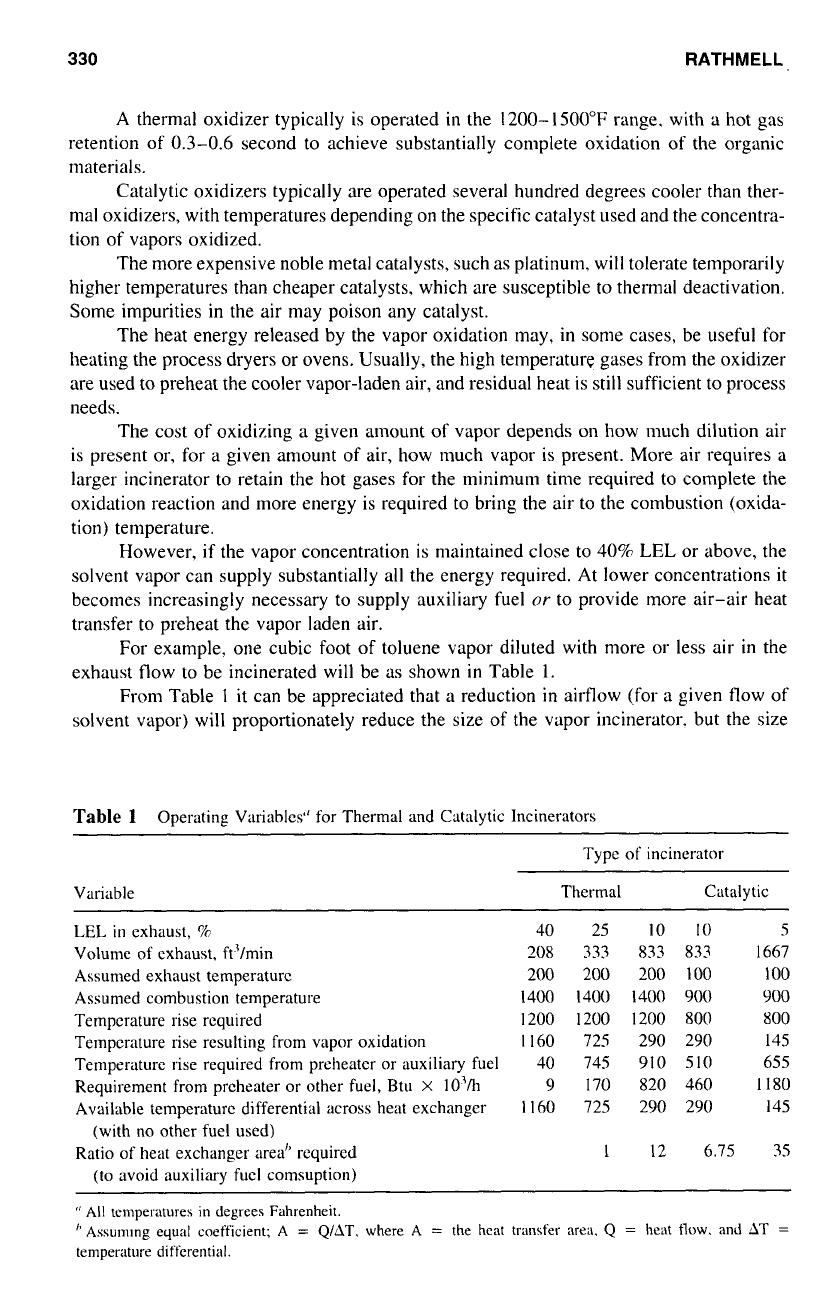
330
RATHMELL
A
thermal oxidizer typically is operated
in
the
1200-
1500°F
range. with a hot gas
retention of
0.3-0.6
second
to
achieve substantially complete oxidation
of
the organic
materials.
Catalytic oxidizers typically are operated several hundred degrees cooler than ther-
mal oxidizers, with temperatures depending on the specific catalyst used and the concentra-
tion of vapors oxidized.
The more expensive noble metal catalysts, such as platinum, will tolerate temporarily
higher temperatures than cheaper catalysts, which are susceptible
to
thermal deactivation.
Some impurities in the air may poison any catalyst.
The heat energy released by the vapor oxidation may, in some cases, be useful for
heating the process dryers or ovens, Usually, the high temperature gases from the oxidizer
are used to preheat the cooler vapor-laden air, and residual heat is still sufficient
to
process
needs.
The cost
of
oxidizing a given amount of vapor depends on how much dilution air
is present or, for a given amount of air, how much vapor is present. More air requires a
larger incinerator to retain the hot gases for the minimum time required to complete the
oxidation reaction and more energy is required to bring the air to the combustion (oxida-
tion) temperature.
However, if the vapor concentration is maintained close to
40%
LEL
or above, the
solvent vapor can supply substantially
all
the energy required. At lower concentrations
it
becomes increasingly necessary to supply auxiliary fuel
or
to
provide more air-air heat
transfer to preheat the vapor laden air.
For example, one cubic foot
of
toluene vapor diluted with more or less air
in
the
exhaust flow to be incinerated will be
as
shown
in
Table
1.
From Table
l
it can be appreciated that a reduction
in
airflow (for a given flow
of
solvent vapor) will proportionately reduce the
size
of
the vapor incinerator. but the size
Table
1
Operating Variables“ for Thermal and Catalytic Incinerators
~~~ ~
Type
of
incinerator
Variable Thermal Catalytic
LEL
in
exhaust,
%
40 25
IO
IO
5
Volume
of
exhaust, ft’lmin
208 333 833 833 1667
Assumed exhaust temperature
200 200
200
100
100
Assumed combustion temperature
1400
1400
1400 900 900
Temperature rise required
1200
1200
1200
800
800
Temperature rise resulting from vapor oxidation
I
160
725
290 290 I45
Temperature rise required from preheater or auxiliary fuel
40 745 91
0
5
10
655
Requirement from preheater or other fuel, Btu
X
10’h
9 170
820 460
1180
Available temperature differential across heat exchanger
1
160
725
290 290 145
Ratio of heat exchanger area” required
I
12 6.75 35
(with no other fuel used)
(to avoid auxiliary fuel comsuption)
‘l
All temperatures in degrees Fahrenheit.
”
AssuInlng equal coefficient; A
=
QlAT.
&,here A
=
the heat trdnsfer area.
Q
=
heat
flow.
and
hT
=
temperature differential.
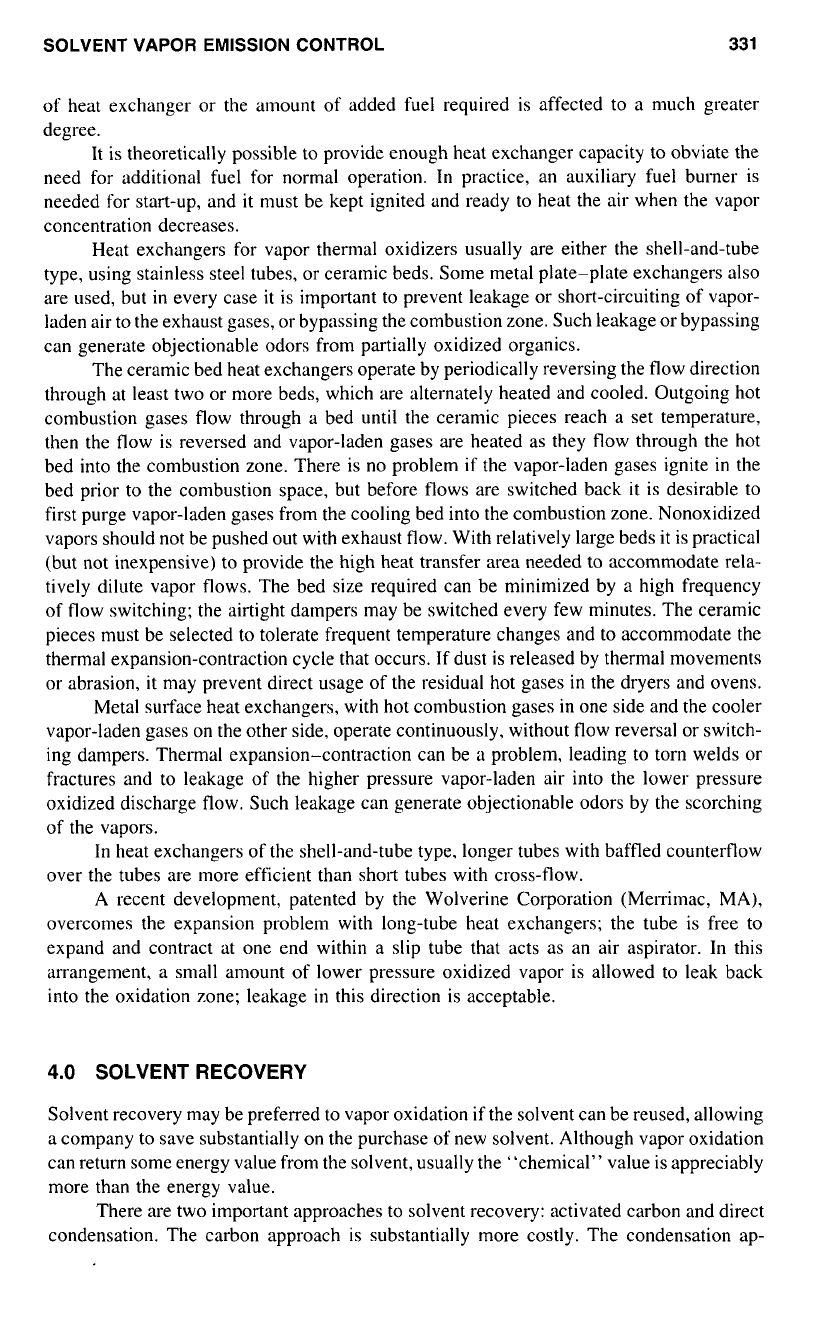
SOLVENT VAPOR EMISSION CONTROL
331
of
heat exchanger or the amount of added fuel required is affected to a much greater
degree.
It is theoretically possible to provide enough heat exchanger capacity to obviate the
need for additional fuel for normal operation. In practice, an auxiliary fuel burner is
needed for start-up, and
it
must be kept ignited and ready to heat the air when the vapor
concentration decreases.
Heat exchangers for vapor thermal oxidizers usually are either the shell-and-tube
type, using stainless steel tubes, or ceramic beds. Some metal plate-plate exchangers also
are used, but in every case
it
is important to prevent leakage or short-circuiting of vapor-
laden air
to
the exhaust gases, or bypassing the combustion zone. Such leakage or bypassing
can generate objectionable odors from partially oxidized organics.
The ceramic bed heat exchangers operate by periodically reversing the flow direction
through at least two or more beds, which are alternately heated and cooled. Outgoing hot
combustion gases flow through a bed until the ceramic pieces reach a set temperature,
then the flow is reversed and vapor-laden gases are heated as they flow through the hot
bed into the combustion zone. There is no problem
if
the vapor-laden gases ignite
in
the
bed prior to the combustion space, but before flows are switched back it is desirable to
first purge vapor-laden gases from the cooling bed into the combustion zone. Nonoxidized
vapors should
not
be pushed out with exhaust flow. With relatively large beds it is practical
(but not inexpensive) to provide the high heat transfer area needed to accommodate rela-
tively dilute vapor flows. The bed size required can be minimized by a high frequency
of
flow switching; the airtight dampers may be switched every few minutes. The ceramic
pieces must be selected to tolerate frequent temperature changes and
to
accommodate the
thermal expansion-contraction cycle that occurs. If dust is released by thermal movements
or abrasion,
it
may prevent direct usage
of
the residual hot gases in the dryers and ovens.
Metal surface heat exchangers, with hot combustion gases in one side and the cooler
vapor-laden gases on the other side, operate continuously, without flow reversal or switch-
ing dampers. Thermal expansion-contraction can be a problem, leading to torn welds or
fractures and to leakage of the higher pressure vapor-laden air into the lower pressure
oxidized discharge flow. Such leakage can generate objectionable odors by the scorching
of
the vapors.
In
heat exchangers of the shell-and-tube type, longer tubes with baffled counterflow
over the tubes are more efficient than short tubes with cross-flow.
A recent development, patented by the Wolverine Corporation (Melrimac, MA),
overcomes the expansion problem with long-tube heat exchangers; the tube is free
to
expand and contract at one end within a slip tube that acts as an air aspirator. In this
arrangement, a small amount of lower pressure oxidized vapor
is
allowed to leak back
into the oxidation zone; leakage
in
this direction is acceptable.
4.0
SOLVENT RECOVERY
Solvent recovery may be preferred to vapor oxidation
if
the solvent can be reused, allowing
a company to save substantially
on
the purchase of new solvent. Although vapor oxidation
can return some energy value from the solvent, usually the “chemical” value is appreciably
more than the energy value.
There are two important approaches to solvent recovery: activated carbon and direct
condensation. The carbon approach is substantially more costly. The condensation ap-
